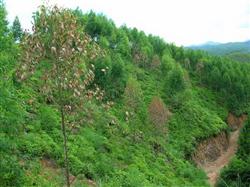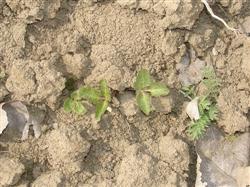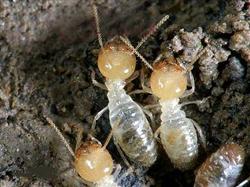How does eucalyptus control bacterial wilt?

How does eucalyptus control bacterial wilt? Bacterial wilt of eucalyptus is a bacterial wilt disease. In recent years, with the continuous increase of eucalyptus varieties (lines) and the rapid increase of plantation area in South China, the occurrence of eucalyptus bacterial wilt is becoming more and more serious and has become an important obstacle to eucalyptus production. In the epidemic year of bacterial wilt of eucalyptus, the incidence of newly built young forest of susceptible eucalyptus varieties (lines) reached 20% to 40%, and that of highly susceptible eucalyptus varieties (lines) reached more than 60%, causing serious economic losses to eucalyptus operators and threatening the sustainable development of eucalyptus industry. 1. The pathogen of bacterial wilt of eucalyptus is Ralstoniasolanacearum (Smith) Yabuuchi, which belongs to race 1 and is biotype Ⅲ, which is the same as Casuarina equisetifolia, tomato and sweet potato in morphological characteristics, staining reaction and physicochemical characteristics, and the pathogenicity of bacterial wilt isolated from different eucalyptus varieties and geographical provenances is basically the same. Ralstoniasolanacearum is a soil resident bacteria that can usually survive in the soil for several years. With the increase of soil temperature and humidity, the activity of pathogens intensified, which was easy to invade the plant directly from the root surface or wound, and then propagated in large numbers in the vascular bundle, resulting in browning and necrosis of the diseased part of eucalyptus, loss of water and wilting of leaves, root rot and blackening, necrotic rhizome with fermentation flavor, and yellowish or milky white bacteria overflowing within a few minutes after moisturizing after cross-cutting. In severe cases, brown necrosis appeared from the rhizome to the phloem of the trunk, and finally the whole plant withered and died. For acute type of bacterial wilt, it usually takes only a few weeks from plant susceptibility to disease and death, while for chronic type of bacterial wilt, the time from plant susceptibility to disease and death is longer, usually 3-6 months. Ralstonia solanacearum can spread through seedling, soil, water source, root contact, agricultural operation and so on. 2. Distribution and occurrence characteristics of bacterial wilt of eucalyptus 2.1 bacterial wilt of eucalyptus is distributed in many countries in the world, and bacterial wilt has been reported in Brazil, Australia, South Africa, Congo, Uganda and other countries. However, the harm is particularly serious in South China. Eucalyptus bacterial wilt was first found in Guangxi, and then there were varying degrees of occurrence and epidemic in Guangdong, Hainan, Fujian, Taiwan, Yunnan and other South China provinces and regions. The main reasons for the epidemic of bacterial wilt of eucalyptus in China are as follows: (1) South China belongs to the subtropical climate, affected by the Pacific monsoon climate, there are plenty of typhoons and Rain Water, warm and humid, and the annual average temperature is between 25 and 35 ℃, which creates favorable conditions for bacterial wilt which is suitable for growth and reproduction in high temperature, high humidity and acidic soil. (2) the epidemic of bacterial wilt in South China is due to the cultivation of susceptible Casuarina equisetifolia or tobacco, tomato and peanut which are susceptible to bacterial wilt in most coastal areas, resulting in an increase in the accumulation and pathogenicity of pathogens. survive for a long time in soil, plant residues and garbage fertilizer. (3) in recent years, fast-growing and high-yielding eucalyptus varieties have been widely planted in various areas, and a large number of susceptible eucalyptus varieties have been blindly planted without taking into account the geographical distribution and the environmental conditions of suitable trees. And little or no inspection and quarantine of seedlings were carried out, resulting in the epidemic of bacterial wilt of eucalyptus in a large area. Click to get more eucalyptus planting techniques click to get more flower planting techniques
- Prev

How should Angelica dahurica be planted?
How should Angelica dahurica be planted? What should be paid attention to, please give guidance to Baizhi sex like warm and humid, sunny, afraid of high temperature, can withstand cold, strong adaptability. Angelica dahurica
- Next

How does eucalyptus control termites?
How does eucalyptus control termites? Please introduce that the common pests of eucalyptus are soil termites, mainly black-winged termites, followed by yellow-winged termites. Although other ant species have been found in the forest, they are not enough to cause harm. 1. The law of harm. In young eucalyptus forests, termites first harm the root neck, and then gradually turn from the soil layer.
Related
- Fuxing push coffee new agricultural production and marketing class: lack of small-scale processing plants
- Jujube rice field leisure farm deep ploughing Yilan for five years to create a space for organic food and play
- Nongyu Farm-A trial of organic papaya for brave women with advanced technology
- Four points for attention in the prevention and control of diseases and insect pests of edible fungi
- How to add nutrient solution to Edible Fungi
- Is there any good way to control edible fungus mites?
- Open Inoculation Technology of Edible Fungi
- Is there any clever way to use fertilizer for edible fungus in winter?
- What agents are used to kill the pathogens of edible fungi in the mushroom shed?
- Rapid drying of Edible Fungi

